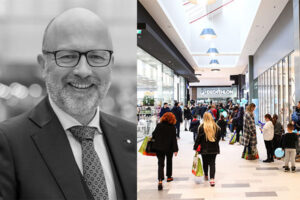By Cindy Andersen
I am told that “let and forget” was once a good-humored saying in retail real estate. It was a reference to the simplicityand predictability of investing in shopping centers. In a world where you built a mall, signed up tenants on long leases, and then sat back and collected the rental income. Sure, a bit of design and asset management was required, but nothing especially spectacular was needed to keep footfall high and your investment successful. How times have changed. Over the last decade changing demographic factors and fast evolving technological trends have impactedthe way people shop and disrupted our industry. The resulting complexities have discouraged many investors from engaging in retail real estate, but I am pleased to say that Ingka Centres isn’t one of them.
We are currently investing around 5 billion euros to transform our business for the future, embarking on new projects in new markets and upgrading our existing portfolio. As we invest, the changing needs of people and the evolution of the retail landscape is at the forefront of our minds, always challenging us to create retail-led destinations that will be relevant to people both now and in the future. This is central to our mission to democratize access to quality spaces and experiences that bring value to individuals, communities, and the planet. We recognize that the traditional model for urban malls needs to evolve in the face of shifts in consumer habits, e-commerce growth, new technologies, urbanization, declining use of private transportation, and a localization of demand towards accessible services and environmental sustainability. All this places different demands on today’s physical retail locations, and the pandemic has further accelerated many of these, and the need to reimagine traditional retail spaces even more.
What’s clear is that retail real estate investors can no longer simply see ourselves or act as owners or operators of shopping centers. Our strategy is to be a creator of what we call “meeting places”. We define that our meeting places are sustainable mixed-use destinations that put customers’ needs and desires at the heart of everything we do. They are always retail-led and IKEA-anchored, but unique in that they are designed around the needs of their respective local communities, reinforcing customer engagement by creating more reasons to visit, more often. They are community focused–with event spaces and social clubs for local businesses–and close to peoples’ homes so they can feel safe in a post-Covid world. As investments they offer positive returns by being future-proofed as community hubs, offering a range of adaptable spaces and different types of tenants to fill the space.
Our approach to “meeting places” is a long-term vision. Around the world, we are on an ongoing journey to shape and share best-practices across countries and consumers. In contrast to the “let and forget” days we understand that you cannot have a “one size fits all” approach. By their very nature everything about our meeting places and what they offer is unique to people living closest to them. This why we are developing assets of all shapes and sizes around the world that bring value to people, communities, and our planet in tune with consumer lifestyles and demographics.
For example, we are developing smaller format, IKEA-anchored urban meeting places because we believe the trend for people wanting to live in large cities will continue in the long term. Increased urbanization means we need our assets to be within easy reach of millions of people, and closer to where they live, work, and spend their leisure time. It is estimated that by 2030 60% of the world’s population will live in larger cities[1]. These urban residents don’t just want out-of-town malls. They want places that provide a vibrant functional mix on their doorstep, where shopping is built around different needs like eating, playing, working, living, and socializing, combined within high-density, well-connected, and walkable areas.
This is why our urban destinations could include F&B, workspace, residential, hotels, or kids play areas for example. From an investment perspective, mixed-use also enables great potential for further density and functional change and increasing the “working day” of the asset outside normal store hours. Our first projects in urban locations are Kings Mall in London and 6×6 in San Francisco, both of which are currently being redeveloped. We intend to introduce more urban meeting places around the world over the coming years. Our work in the Hunan province of central China is a great example of how we’re stretching the concept of what our meeting places can offer to a local community. Our Changsha meeting place is our first mixed-use development, adding a Livat center with an IKEA store to unique, IKEA-inspired, work-live spaces. Our investment will offer customers and residents a work, live, play experience and reflect our commitment to stand for social aspiration, leisure, entertainment and food, and to champion retail that excites and unites communities.
So, what for the larger more traditional out-of-town retail-led destinations? We still see excellent opportunities for large-scale, retail-led, mixed-use projects, especially in locations like China and India where the market for retail offerings is still developing. And we believe there will always be demand for regional leisure destinations that offer family days out with timeless offerings such as parks, homes and squares. This is why earlier this year we expanded into India with the acquisition of a land plot in Noida, Uttar Pradesh where we will create a major new IKEA-anchored destination. We also continue to upgrade assets such as our supra regional MEGA branded malls in Russia to transform them into more mixed-use leisure destinations. Overall, we will continue to develop a portfolio of diverse assets, starting from large-scaled mixed-use schemes to smaller urban formats.
Working with our tenants, and as investors in new experiences, we need to ensure the bridge between physical and online retail becomes stronger, more seamless and connected to deliver better customer experiences and service. Retail real estate should inspire people to live more sustainable as well as more connected lives. Businesses like ours who attract millions of people have a unique opportunity to do this. Retail of the future should be built around a more sustainable offer, recycling schemes, repair cafes, eco-schools, better integrated public transport links, EV charging points and more. We see our role in making sustainable investments. As part of Ingka Group, we joined the Paris Agreement and we work to make sure that our assets can make a positive impact on the environment.
The “let and forget” mantra is history. The result? Our industry is reinventing itself to create places that are even more exciting, sustainable, and valuable for future generations.
[1] United Nations – the world’s cities





